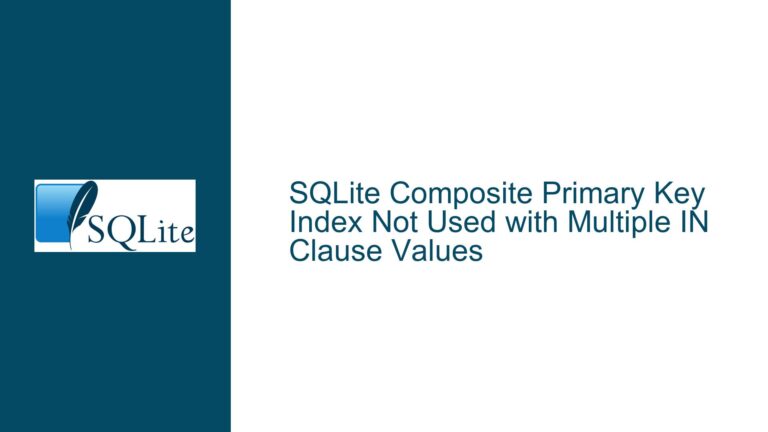Optimizing Queries on Mixed-Text-Numeric Columns in SQLite
SQLite’s Storage Classes, Index Behavior, and Mixed-Data Query Challenges
Issue Overview
SQLite employs dynamic typing, allowing columns to hold values of different storage classes (INTEGER, REAL, TEXT, BLOB, or NULL). This flexibility introduces challenges when indexing and querying columns containing mixed text and numeric data. For example, a column defined with NUMERIC affinity may implicitly convert text representations of numbers (e.g., '11') to integers or reals, while a TEXT or BLOB affinity column preserves literal values. Queries filtering or sorting such columns must account for how SQLite’s type-handling rules interact with indexes.
A key concern arises when attempting to optimize queries that target either numeric or textual values within the same column. Users often assume partial indexes (e.g., one index for numeric entries and another for text entries) are necessary to improve performance. However, SQLite’s indexing mechanics rely on the storage class of the indexed values, not their declared affinity. An index on a BLOB or NUMERIC column will naturally sort values according to their storage class hierarchy (e.g., INTEGER < REAL < TEXT < BLOB). This means a single index can efficiently serve queries targeting specific storage classes, provided the query predicates match the stored type.
For instance, a query using WHERE column = 11 will not match '11' stored as TEXT, even if the literal 11 is an integer. Conversely, WHERE column = '11' will match the TEXT value but not the INTEGER 11. This behavior stems from SQLite’s strict type comparisons in indexes. Unique constraints further complicate this: inserting 1 (INTEGER) and '1' (TEXT) into a column with a UNIQUE constraint will succeed because they are distinct storage classes.
Root Causes of Query-Index Mismatches and Performance Degradation
1. Type Affinity vs. Storage Class Misalignment
Columns declared with NUMERIC, INTEGER, or TEXT affinity do not enforce strict typing but influence how values are converted during insertion. A NUMERIC column will attempt to convert text values to integers or reals if possible, potentially altering the stored data. For example, inserting '3.0abc' into a NUMERIC column stores it as TEXT because the string is not purely numeric, whereas '13' becomes INTEGER. This inconsistency disrupts indexing predictability.
2. Implicit Casting During Queries
SQLite performs limited type conversions when comparing values. A predicate like WHERE column = 11 will only match INTEGER or REAL values, ignoring TEXT '11'. This forces full-table scans if the query’s literal type does not align with the indexed storage class. For example, a TEXT-heavy column with an index will not utilize the index for numeric comparisons unless the query explicitly casts the column or uses type-specific literals.
3. Unique Indexes and Type-Specific Duplicates
A UNIQUE index on a mixed-type column treats 11 (INTEGER) and '11' (TEXT) as distinct entries. While this preserves data integrity, it can lead to unintended duplicates when applications inconsistently handle data types (e.g., inserting 42 as INTEGER in one case and '42' as TEXT in another).
4. Index Key Storage Overhead
Indexes in SQLite store keys based on their storage class. Mixing TEXT and numeric values in a single column increases index size and fragmentation, as the B-tree structure must accommodate heterogeneous data types. This reduces the efficiency of range queries and index traversals.
Designing Robust Schemas and Queries for Mixed-Type Columns
1. Column Affinity Selection
- Use
BLOBfor Exact Storage: Declare the column asBLOBto disable all implicit type conversions. This ensures'11'(TEXT) and11(INTEGER) are stored verbatim. - Avoid
NUMERICfor Mixed Data:NUMERICaffinity may convert some text values to integers/reals, leading to data loss (e.g.,'123.45xyz'becomes TEXT, but'123.45'becomes REAL).
Example:
CREATE TABLE records (
id INTEGER PRIMARY KEY,
mixed_data BLOB
);
CREATE INDEX idx_mixed ON records(mixed_data);
2. Indexing Strategy
- Single Index Sufficiency: A single index on a
BLOBorTEXTcolumn can efficiently serve both numeric and text queries if the application consistently uses type-specific literals. - Partial Indexes for Filtered Subsets: If queries frequently target a subset of types (e.g., all numeric values), create a partial index:
CREATE INDEX idx_numeric ON records(mixed_data)
WHERE typeof(mixed_data) IN ('integer', 'real');
This index will only include numeric values, reducing its size and improving lookup speed for numeric queries.
3. Query Formulation
- Explicit Type Casting: Use
CAST()to harmonize types in predicates:
SELECT * FROM records WHERE CAST(mixed_data AS TEXT) = '11';
Caution: Casting in WHERE clauses may bypass indexes.
- Type-Specific Literals: Ensure literals match the storage class of indexed values. For a
BLOBcolumn storing TEXT and INTEGER:
-- Matches TEXT '11'
SELECT * FROM records WHERE mixed_data = '11';
-- Matches INTEGER 11
SELECT * FROM records WHERE mixed_data = 11;
4. Handling Unique Constraints
To prevent duplicates across storage classes, add a computed column that normalizes the data type:
CREATE TABLE records (
id INTEGER PRIMARY KEY,
mixed_data BLOB,
data_type TEXT GENERATED ALWAYS AS (typeof(mixed_data)) VIRTUAL,
UNIQUE(mixed_data, data_type)
);
This ensures 11 (INTEGER) and '11' (TEXT) are treated as distinct unique entries.
5. Performance Analysis
Use EXPLAIN QUERY PLAN to verify index usage:
EXPLAIN QUERY PLAN
SELECT * FROM records WHERE mixed_data = 11;
If the output shows SCAN TABLE records instead of USING INDEX, the query’s literal type does not match the index key’s storage class.
6. Migration of Existing Data
For legacy tables with inconsistent typing, add a normalized column:
ALTER TABLE records ADD COLUMN mixed_data_normalized BLOB;
UPDATE records SET mixed_data_normalized =
CASE WHEN typeof(mixed_data) IN ('integer', 'real')
THEN CAST(mixed_data AS BLOB)
ELSE mixed_data END;
CREATE INDEX idx_normalized ON records(mixed_data_normalized);
7. Storage Class Hierarchy Awareness
SQLite compares values across storage classes using fixed rules:
NULL < INTEGER/REAL < TEXT < BLOB
A query like WHERE mixed_data < 100 will include INTEGER/REAL values but exclude TEXT and BLOB, even if they represent numbers.
8. Application-Level Consistency
Enforce strict data typing in the application layer. For example, always insert numbers as integers/reals and non-numeric data as TEXT/BLOB. This eliminates ambiguity in queries and indexes.
9. Benchmarking Mixed vs. Segregated Columns
For high-performance systems, consider splitting mixed data into separate columns:
CREATE TABLE records (
id INTEGER PRIMARY KEY,
numeric_value REAL,
text_value TEXT,
CHECK (numeric_value IS NOT NULL OR text_value IS NOT NULL)
);
This allows dedicated indexes and eliminates type comparison overhead.
10. Leveraging STRICT Tables (SQLite 3.37+)
Use STRICT mode to enforce column typing:
CREATE TABLE records (
id INTEGER PRIMARY KEY,
mixed_data ANY
) STRICT;
This restricts mixed_data to the declared type (e.g., ANY allows all types but prevents affinity-based conversions).
By aligning schema design, indexing, and query patterns with SQLite’s type-handling mechanics, developers can optimize mixed-type columns without resorting to complex workarounds.






